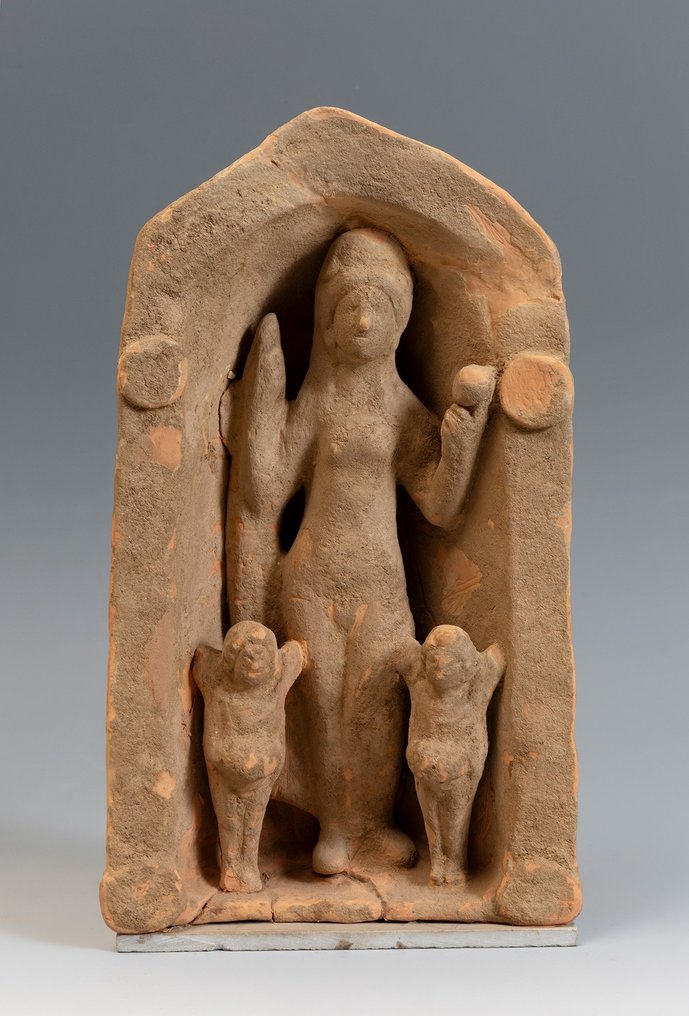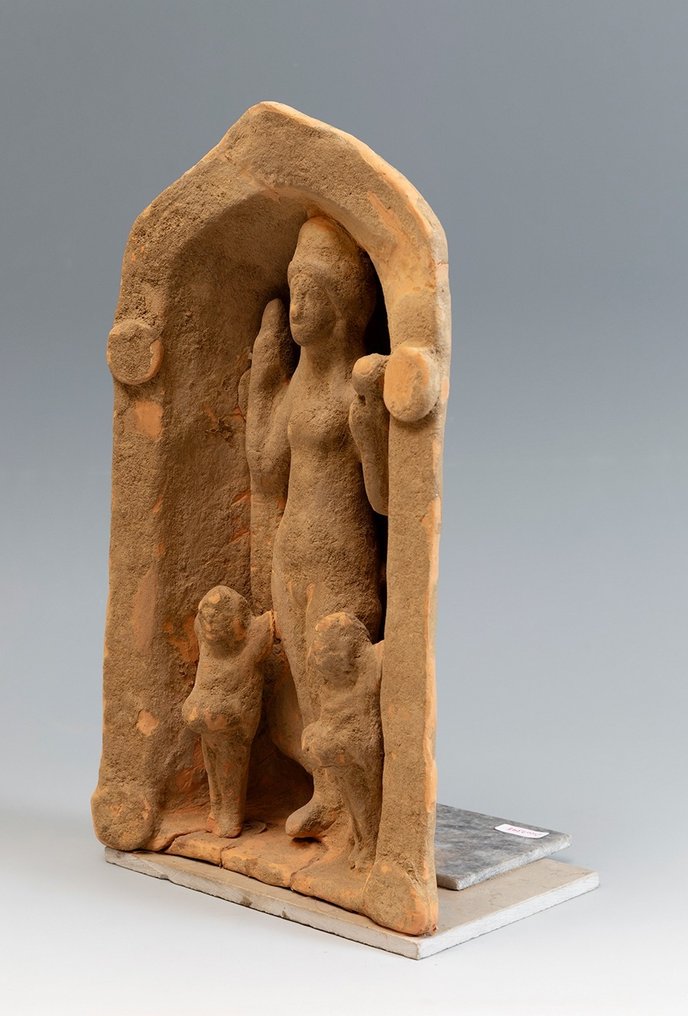Magnífica la entrega y el objeto. Perfecta la sonido del sibato
Ver traduzidoGrécia Antiga Terracota Bela estela da deusa do amor Afrodite - Vênus com dois Eros - Cupido. 27 cm H. Exportação Espanhola
N.º 88174109



Nice and pretty stela of goddess of love Aphrodite - Venus with two Eros - Cupid
Venus Chastising Cupid
Ancient Greek, 4th - 2nd century BC
27 heigth and 15 cm large.
PROVENANCE: Private collection Mr. L., south of France, before 1980. Old label in the back.
CONDITION: Good, onlye a breakline in the up of the temple see photos.
DESCRIPTION:
In this intimate sculptural portrayal of a relationship between two divinities, Aphrodite playfully threatens her mischievous son, Eros. The goddess of love wears a stephane--a crown--over her cascading hair and holds a folded cestus--a girdle--just above her shoulder, ready to slap her son. Eros--his wings fully extended--playfully holds up his hand to protect himself.
This scene represents a divine counterpart to the everyday closeness between a mortal mother and her son. During the Hellenistic era, gods and goddesses were often portrayed in a more personal way. This method of representation was a dramatic departure from the earlier Classical style, when the gods were represented more formally as gods, rather than as lighthearted--and humanlike--creatures.
Aphrodite was the goddess of beauty, love and fertility, embodying the primal forces of creation. From the 3rd century BC, she was identified with Venus by the Romans, their local divinity related to the same forces. The goddess, according to Hesiod, was born from foam – the sperm – in the surrounding sea which came from the cut-off genitals of Uranus. In the origins of the Universe, Uranus (the Heavens) mated with Gea (the Earth), engendering various children. But out of fear that they would take the throne from him, he kept them imprisoned in the body of their mother. Cronus, tired of this situation, managed to gain power, castrating his own father and throwing the genitals into the sea:
“From out of the foam a young woman was born. At first, she floated ashore towards the divine Cythera and from there she went to Cyprus… The august and beautiful goddess emerged from the sea, and around her delicate feet grew grass. (…) At first when she was born, and later when she went to join the body of the gods, Eros accompanied her as did the handsome Himeros. And she possessed these attributes (…): intimacy with young maidens, smiles, deceptions, sweet pleasure, love and tenderness.”
Eros, in Greek religion, god of love. In the Theogony of Hesiod (fl. 700 BCE), Eros was a primeval god, son of Chaos, the original primeval emptiness of the universe, but later tradition made him the son of Aphrodite, goddess of sexual love and beauty, by either Zeus (the king of the gods), Ares (god of war and of battle), or Hermes (divine messenger of the gods). Eros was a god not simply of passion but also of fertility. His brother was Anteros, the god of mutual love, who was sometimes described as his opponent. The chief associates of Eros were Pothos and Himeros (Longing and Desire). Later writers assumed the existence of a number of Erotes (like the several versions of the Roman Amor). In Alexandrian poetry he degenerated into a mischievous child. In Archaic art he was represented as a beautiful winged youth but tended to be made younger and younger until, by the Hellenistic period, he was an infant. His chief cult centre was at Thespiae in Boeotia, where the Erotidia were celebrated. He also shared a sanctuary with Aphrodite on the north wall of the Acropolis at Athens. Cupid, ancient Roman god of love in all its varieties, the counterpart of the Greek god Eros and the equivalent of Amor in Latin poetry. According to myth, Cupid was the son of Mercury, the winged messenger of the gods, and Venus, the goddess of love. He often appeared as a winged infant carrying a bow and a quiver of arrows whose wounds inspired love or passion in his every victim. He was sometimes portrayed wearing armour like that of Mars, the god of war, perhaps to suggest ironic parallels between warfare and romance or to symbolize the invincibility of love.
Notes:
- The piece includes authenticity certificate.
- The piece includes Spanish Export License (Passport for European Union) - If the piece is destined outside the European Union a substitution of the export permit should be requested, can take between 1-2 weeks maximum.
- The seller guarantees that he acquired this piece according to all national and international laws related to the ownership of cultural property. Provenance statement seen by Catawiki.
#ancientcivilisations
Mais sobre o vendedor
Nice and pretty stela of goddess of love Aphrodite - Venus with two Eros - Cupid
Venus Chastising Cupid
Ancient Greek, 4th - 2nd century BC
27 heigth and 15 cm large.
PROVENANCE: Private collection Mr. L., south of France, before 1980. Old label in the back.
CONDITION: Good, onlye a breakline in the up of the temple see photos.
DESCRIPTION:
In this intimate sculptural portrayal of a relationship between two divinities, Aphrodite playfully threatens her mischievous son, Eros. The goddess of love wears a stephane--a crown--over her cascading hair and holds a folded cestus--a girdle--just above her shoulder, ready to slap her son. Eros--his wings fully extended--playfully holds up his hand to protect himself.
This scene represents a divine counterpart to the everyday closeness between a mortal mother and her son. During the Hellenistic era, gods and goddesses were often portrayed in a more personal way. This method of representation was a dramatic departure from the earlier Classical style, when the gods were represented more formally as gods, rather than as lighthearted--and humanlike--creatures.
Aphrodite was the goddess of beauty, love and fertility, embodying the primal forces of creation. From the 3rd century BC, she was identified with Venus by the Romans, their local divinity related to the same forces. The goddess, according to Hesiod, was born from foam – the sperm – in the surrounding sea which came from the cut-off genitals of Uranus. In the origins of the Universe, Uranus (the Heavens) mated with Gea (the Earth), engendering various children. But out of fear that they would take the throne from him, he kept them imprisoned in the body of their mother. Cronus, tired of this situation, managed to gain power, castrating his own father and throwing the genitals into the sea:
“From out of the foam a young woman was born. At first, she floated ashore towards the divine Cythera and from there she went to Cyprus… The august and beautiful goddess emerged from the sea, and around her delicate feet grew grass. (…) At first when she was born, and later when she went to join the body of the gods, Eros accompanied her as did the handsome Himeros. And she possessed these attributes (…): intimacy with young maidens, smiles, deceptions, sweet pleasure, love and tenderness.”
Eros, in Greek religion, god of love. In the Theogony of Hesiod (fl. 700 BCE), Eros was a primeval god, son of Chaos, the original primeval emptiness of the universe, but later tradition made him the son of Aphrodite, goddess of sexual love and beauty, by either Zeus (the king of the gods), Ares (god of war and of battle), or Hermes (divine messenger of the gods). Eros was a god not simply of passion but also of fertility. His brother was Anteros, the god of mutual love, who was sometimes described as his opponent. The chief associates of Eros were Pothos and Himeros (Longing and Desire). Later writers assumed the existence of a number of Erotes (like the several versions of the Roman Amor). In Alexandrian poetry he degenerated into a mischievous child. In Archaic art he was represented as a beautiful winged youth but tended to be made younger and younger until, by the Hellenistic period, he was an infant. His chief cult centre was at Thespiae in Boeotia, where the Erotidia were celebrated. He also shared a sanctuary with Aphrodite on the north wall of the Acropolis at Athens. Cupid, ancient Roman god of love in all its varieties, the counterpart of the Greek god Eros and the equivalent of Amor in Latin poetry. According to myth, Cupid was the son of Mercury, the winged messenger of the gods, and Venus, the goddess of love. He often appeared as a winged infant carrying a bow and a quiver of arrows whose wounds inspired love or passion in his every victim. He was sometimes portrayed wearing armour like that of Mars, the god of war, perhaps to suggest ironic parallels between warfare and romance or to symbolize the invincibility of love.
Notes:
- The piece includes authenticity certificate.
- The piece includes Spanish Export License (Passport for European Union) - If the piece is destined outside the European Union a substitution of the export permit should be requested, can take between 1-2 weeks maximum.
- The seller guarantees that he acquired this piece according to all national and international laws related to the ownership of cultural property. Provenance statement seen by Catawiki.
#ancientcivilisations
Mais sobre o vendedor
- 818
- 10
- 1
very well packed with all the documents included, thnks
Ver traduzidoGreat object. Really beautiful. Quick delivery. Excellent.
Ver traduzidoSuperbe objet, Service d'Arqueologia Ancient Art excellent et rapide. Jaume Bagot toujours parfait .
Ver traduzidoTodo perfecto gracias
Ver traduzidoNice item all ok A+++
Ver traduzidoThank you for this Oinochoe, one question: did you as promised read my post!
Ver traduzidoVery cooperative in every aspect of the transaction.
Ver traduzidoAlways a great pleasure!
Ver traduzidoFine quality, good service. Thanks.
Ver traduzidoMuy amables, muy bien todo. Gracias
Ver traduzidoAlles bestens
Ver traduzidoexactly as described and shipped safely and punctually.
Ver traduzidoschnelle Lieferung sehr sichere Verpackung alles bestens
Ver traduzidotres bel objet je le recherchai depuis longtemps envoi rapide et protégé je pense qu'il y aura d'autres achats avec ce vendeur merci +++++++
Ver traduzidoEinfach nur toll
Ver traduzidoTodo perfecto
Ver traduzidoottimo
Ver traduzidoperfetto
Ver traduzidotop oggetto bellissimo grazie 💯💯💯💯💯💯 :-)
Ver traduzidoI bought this beautiful artifact together with artifact from Mr. Bagot but although it is clearly stated on his shipping page that when purchasing multiple artifacts i paid the double package costs
Ver traduzidoI bought this beautiful artifact together with artifact from Mr. Bagot but although it is clearly stated on his shipping page that when purchasing multiple artifacts i paid the double package costs
Ver traduzidoBel objet, bien emballé. Parfait.
Ver traduzidowonderful faiece and very fast shipping.thanks a lot
Ver traduzidoJ Bagot es un profesional excelente. Sus artículos son de gran calidad, se incluye la documentación necesaria y el embalaje se realiza con esmero. Le recomiendo encarecidamente.
Ver traduzido- 818
- 10
- 1
Magnífica la entrega y el objeto. Perfecta la sonido del sibato
Ver traduzidoAviso Legal
O vendedor garante e pode provar que o objeto foi obtido legalmente. O vendedor foi informado pela Catawiki que tinha de fornecer a documentação exigida pelas leis e regulamentos do seu país de residência. O vendedor garante que tem o direito de vender/exportar este objeto. O vendedor fornecerá ao comprador toda a informação conhecida sobre a proveniência do objeto. O vendedor garante que serão ou já foram obtidas todas as autorizações necessárias. O vendedor informará imediatamente o comprador de quaisquer atrasos na obtenção de tais autorizações.
O vendedor garante e pode provar que o objeto foi obtido legalmente. O vendedor foi informado pela Catawiki que tinha de fornecer a documentação exigida pelas leis e regulamentos do seu país de residência. O vendedor garante que tem o direito de vender/exportar este objeto. O vendedor fornecerá ao comprador toda a informação conhecida sobre a proveniência do objeto. O vendedor garante que serão ou já foram obtidas todas as autorizações necessárias. O vendedor informará imediatamente o comprador de quaisquer atrasos na obtenção de tais autorizações.









